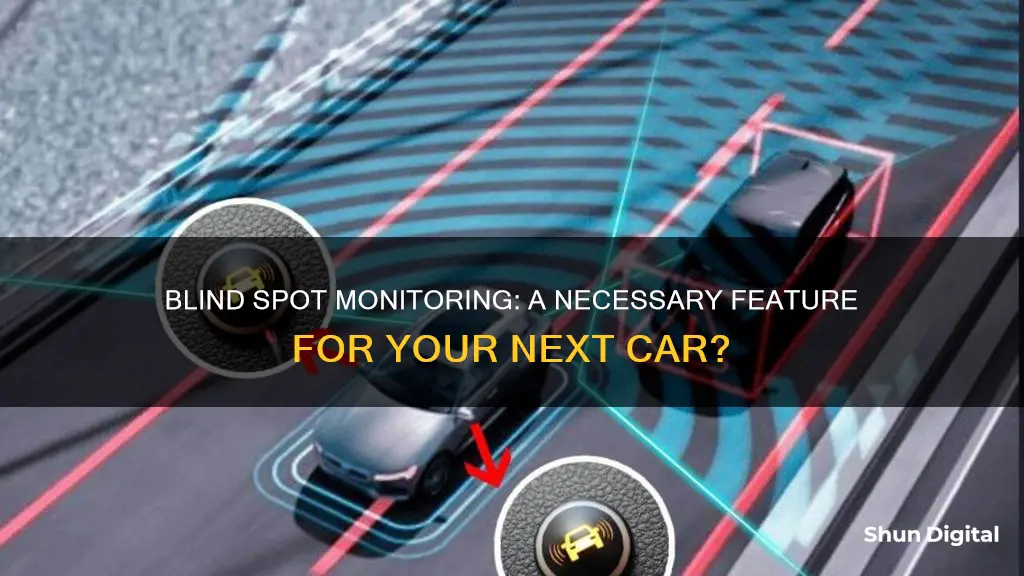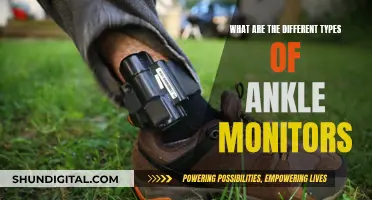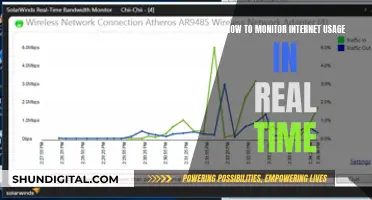
Blind-spot monitoring (BSM) is a safety feature in cars that helps keep an eye on the spaces just off the rear quarter areas of your vehicle, which are often hidden from the driver's view. This feature is especially useful for changing lanes or merging, as it can help prevent crashes by alerting the driver to vehicles approaching in adjacent lanes. While BSM was once only found in high-end luxury cars, it is now available across a range of vehicles, from subcompact cars to trucks and SUVs. In this article, we will discuss the benefits of BSM, how it works, and whether it is worth investing in this technology for your next car.
| Characteristics | Values |
|---|---|
| What is it? | A system that uses sensors, cameras, and sometimes radar, sonar, or lidar to detect vehicles in a car's blind spot. |
| How does it work? | Sensors detect vehicles in the blind spot and trigger an alert. Indicators notify the driver of the potential danger through visual and/or audio warnings. |
| Benefits | Prevents accidents, increases driving awareness, increases response time, reduces driver stress, and makes drivers and passengers feel safer. |
| Types of systems | Alert-only systems provide a visual and/or audio warning. More advanced systems also provide steering assistance to avoid a collision. |
| Installation | Aftermarket blind spot monitoring systems can be installed in older vehicles but require professional installation. Factory-installed systems are more common and seamless. |
| Cost | Aftermarket systems range from $250 to $500 or more, depending on accuracy and functionality. |
| Examples | Toyota, Honda, Nissan, Hyundai, Ford, Chevrolet, Audi, BMW, and Mercedes-Benz offer blind spot monitoring systems. |
What You'll Learn

Increased safety and confidence for drivers and passengers
Blind-spot monitoring (BSM) is an active driver aid and safety device that can increase safety and confidence for drivers and passengers. It can detect vehicles, objects, or pedestrians that the driver might not see, providing an early warning and increasing response time. This can be especially useful when changing lanes or merging, preventing crashes and minimising the severity of others.
BSM systems use sensors, cameras, or a combination of both, to detect vehicles in adjacent lanes. When something enters the vehicle's blind spot, the driver is alerted through visual, audible, or tactile warnings. Visual alerts may include a yellow warning light on the side-view mirror, while audible alerts may be a chime or beep. More advanced systems may also provide tactile alerts, such as vibrating the steering wheel or applying pressure to the steering to nudge the driver back towards the centre of the lane.
The benefits of BSM are particularly noticeable in larger vehicles, which tend to have bigger blind spots. BSM can also be useful when towing a trailer, as systems from Ford and Ram can detect attached trailers and monitor traffic alongside them. Additionally, BSM is valuable for drivers of older or larger vehicles who may have difficulty seeing around their vehicle. By providing an extra set of "eyes" on the road, BSM reduces stress and increases confidence for drivers and their passengers.
While BSM is not a substitute for proper mirror adjustment and cautious driving habits, it can provide valuable assistance and help prevent accidents.
Finding Monitor Information in the Windows Registry
You may want to see also

Reduced stress from driving in close quarters
Driving in close quarters can be stressful, especially when you're dealing with blind spots. That's where blind spot monitoring (BSM) comes in – it's an active driver aid that uses sensors and sometimes side-mounted cameras to detect vehicles or objects in your blind spots, giving you an early warning so you can take action. This is particularly useful when you're merging lanes or driving in heavy traffic.
BSM systems can provide both visual and audible alerts, and some more advanced systems might even nudge you away from potential hazards through steering or brake pressure. This can be incredibly valuable when you're driving in close quarters, as it gives you more time to react and make necessary adjustments.
The larger your vehicle, the bigger the blind spots tend to be, and this is where BSM can be especially beneficial. It can help you navigate tight spaces and manoeuvre with more confidence, knowing that you have an extra set of "eyes" keeping track of your surroundings. This can be a game-changer when navigating busy streets or crowded parking lots.
Additionally, BSM can be a great safety feature for drivers of all experience levels. For new drivers, it can provide an added layer of security as they learn to navigate the roads. For experienced drivers, it can reduce stress levels and help them feel more confident and in control, especially when driving in unfamiliar areas or challenging conditions.
While BSM is not a replacement for safe driving practices and manual checks, it can certainly complement them. By utilising both the technology and your own vigilance, you can enhance your overall driving experience and reduce the stress that comes with driving in close quarters.
Acer Monitor SNID: Finding Your Serial Number
You may want to see also

Improved driving awareness
Blind-spot monitoring (BSM) is an active driver aid that can significantly improve driving awareness. It does what its name suggests: it keeps an eye on the space just off the rear quarter areas of your vehicle, which are often the driver's blind spots. These spots can hide vehicles approaching in adjacent lanes, especially when mirrors are improperly set. As a result, merging into another vehicle is a common issue. According to the National Highway Traffic Safety Administration (NHTSA), around 9% of all reported vehicle crashes each year occur due to changing lanes or merging.
BSM systems use sensors, cameras, or a combination of both to detect vehicles, objects, or pedestrians in a car's blind spots. When something enters the blind spot, the system alerts the driver through visual, audible, or tactile warnings. Visual alerts may include a yellow warning light on the side-view mirror, the A-pillar (the pillar between the windshield and the front door), the driver information display, or the head-up display. Audible alerts may be used in conjunction with visual alerts, especially when a driver indicates to merge with a turn signal. Some advanced systems even provide tactile warnings by nudging the driver away from the lane marker or steering the car back to the centre of the lane.
BSM systems can prevent accidents and increase driving awareness by alerting drivers to potential hazards they might otherwise miss. They also reduce stress by providing drivers with an extra set of eyes on the road. This is especially beneficial for larger vehicles, which tend to have bigger blind spots.
Aftermarket blind spot monitoring kits are available for older vehicles that are not equipped with factory-installed systems. These kits typically include sensors and indicators, with some allowing customisation of alert volumes and types. While professional installation is recommended, it is possible to install these kits yourself with some tools and time.
Monitoring Electrical Usage: Individual Breakers and Their Secrets
You may want to see also

More time to respond to potential dangers
Blind-spot monitoring systems (BSM) are designed to keep drivers and passengers safe by alerting them to potential hazards. They are especially useful for larger vehicles, which have bigger blind spots.
BSM systems use sensors, cameras, and sometimes side-mounted cameras to detect vehicles in adjacent lanes. They then warn the driver with an audible or visual alert, or a combination of the two.
The early warning provided by BSM systems gives drivers more time to respond to potential dangers. This extra time can be the difference between a near-miss and a collision. It also reduces the stress of driving in close quarters and increases driver confidence.
Some BSM systems are more advanced and will actively prevent a collision by nudging the driver away from the lane marker or even steering the vehicle back into the centre of the lane. This extra functionality adds another layer of security and further reduces the risk of an accident.
Aftermarket BSM kits are available for older vehicles not equipped with this technology. These kits typically include sensors and indicators, with some form of visual and audio alert. Professional installation is recommended, but self-installation is also possible.
Display Arduino Serial Monitor Data on LCD Screen
You may want to see also

Aftermarket options for older vehicles
Aftermarket blind spot monitoring systems are a great option for older vehicles that lack certain types of technology. These systems can help prevent accidents by alerting you to potential hazards in your blind spots, increasing your driving awareness, and reducing your stress levels.
There are two main types of aftermarket blind spot monitoring systems: custom-designed kits geared towards specific vehicles and universal kits that can be used regardless of the age, make, and model of your car. Custom-designed kits are offered by a growing number of companies, including start-ups and major auto parts manufacturers. Universal kits, on the other hand, are designed to be compatible with a wide range of vehicles.
The main components of an aftermarket blind spot monitoring system are the sensors and the indicators. The sensors act as the "eyes" of the system, using technologies like radar, sonar, and lidar to detect objects in your blind spots. The indicators alert you to potential dangers by providing visual and/or audio signals. Most kits include LED lights and an alarm, and some even allow you to control the volume of the indicator.
When choosing an aftermarket blind spot monitoring system, consider factors such as accuracy, ease of installation, and additional features like Lane Changing Assist and Rear View Blind Spot Detection. The cost of these systems can vary, with the most affordable options starting at around $250 and the higher-end systems costing $500 or more.
While it is possible to install an aftermarket blind spot monitoring system yourself, professional installation is recommended to ensure proper functionality and placement of the sensors and indicators. The installation process can be fairly involved and may require tools and knowledge that the average driver does not have.
Aftermarket blind spot monitoring systems offer a great way to enhance the safety and functionality of older vehicles, providing drivers with an extra set of "eyes" on the road and helping to prevent accidents.
Finding Ports Using Resource Monitor: A Step-by-Step Guide
You may want to see also
Frequently asked questions
Blind-spot monitoring (BSM) uses sensors and sometimes cameras to detect vehicles in a car's blind spots and alert the driver with a warning light or chime.
Blind-spot monitoring systems use sensors and sometimes cameras to detect vehicles in adjacent lanes. When the system detects a vehicle, it alerts the driver with a warning light or chime. Some systems also provide steering assistance to prevent collisions.
Blind-spot monitoring can prevent accidents, increase driving awareness, and reduce stress while driving. It can also provide peace of mind for drivers who transport children or have limited visibility.
Aftermarket blind-spot monitoring systems range in price from $250 to $500 or more. The cost depends on the accuracy and functionality of the system.







